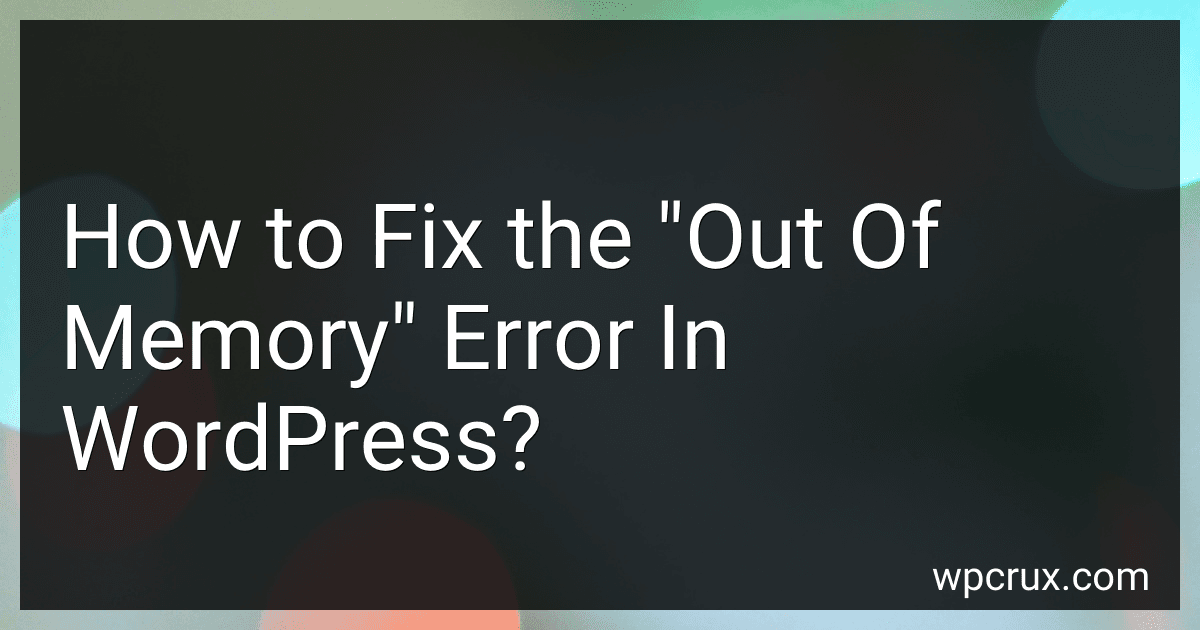Best Plugins to Fix WordPress Memory Issues to Buy in October 2025
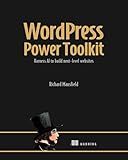
WordPress Power Toolkit: Harness AI to build next-level websites



SEO for WordPress: How To Get Your Website on Page #1 of Google...Fast!



WordPress To Go: How To Build A WordPress Website On Your Own Domain, From Scratch, Even If You Are A Complete Beginner


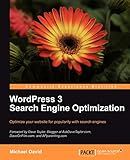
WordPress 3 Search Engine Optimization


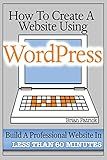
How To Create A Website Using Wordpress: The Beginner's Blueprint for Building a Professional Website in Less Than 60 Minutes


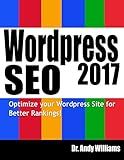
Wordpress SEO 2017: Optimize your Wordpress Site for Better Rankings! (Webmaster Series)


The "out of memory" error in WordPress typically occurs when your website exceeds the memory limit allocated to it by your hosting provider. This can lead to issues such as slow loading times, 500 internal server errors, or even complete site crashes.
To fix this error, you can try the following troubleshooting steps:
- Increase PHP Memory Limit: Access the wp-config.php file in the root folder of your WordPress installation and add the following line of code just before the line that says "That's all, stop editing! Happy blogging": define('WP_MEMORY_LIMIT', '256M'); This code increases the PHP memory limit to 256 megabytes. You can adjust the value if needed.
- Deactivate Unnecessary Plugins: Some plugins are known to consume a lot of memory. Deactivate any unnecessary or resource-intensive plugins, and check if the error persists. You can reactivate them one by one to identify the problematic plugin.
- Switch to a Default Theme: Temporarily switch to a default WordPress theme, such as Twenty Twenty, to determine if the error is caused by your current theme. If the error is gone, you may need to contact the theme developer for a fix.
- Optimize and Reduce Database Usage: Optimize your WordPress database to reduce its size and improve performance. You can use plugins like WP-Optimize or WP-Sweep to clean up and optimize your database.
- Increase Server Memory Limit: If you have access to your server's PHP configuration file (php.ini), you can try increasing the memory limit there. Look for the line that says "memory_limit" and change its value to something like "256M" or higher.
- Contact Hosting Provider: If none of the above solutions work, contact your hosting provider for assistance. They can check server logs and help you diagnose and resolve the memory issue.
Remember to take a backup of your WordPress site before making any changes to avoid any potential data loss.
How to disable unnecessary plugins to alleviate memory load?
To disable unnecessary plugins and reduce memory load, you can follow these steps:
- Open your web browser and go to the settings/menu area. This can usually be found by clicking on the three vertical dots or three horizontal lines in the top-right or top-left corner of your browser window.
- Look for an option called "Extensions" or "Add-ons" in the settings/menu area and click on it. This will open a new tab or window displaying a list of all the installed plugins or extensions.
- Review the list of installed plugins/extensions and identify the ones that you do not need or use frequently. These can include ad blockers, social media plugins, shopping extensions, etc.
- Once you have identified the unnecessary plugins/extensions, locate the disable or remove option associated with them. This can usually be found next to each plugin/extension name or within a settings menu for each individual plugin/extension.
- Click on the disable or remove option to deactivate or uninstall the unnecessary plugins/extensions. Some browsers might require you to confirm your action.
- Repeat the process for each unnecessary plugin/extension until you have disabled or removed them all.
- After disabling or removing the unnecessary plugins/extensions, restart your browser to apply the changes.
By disabling or removing unnecessary plugins/extensions, you can reduce the memory load and improve the overall performance of your web browser.
How to optimize images to reduce memory consumption in WordPress?
Reducing memory consumption can be achieved by optimizing images in WordPress. Here are some steps you can follow to optimize images:
- Resize Images: Use image editing software or online image compression tools to resize your images to the appropriate dimensions required by your website. This will reduce the file size and load times.
- Compress Images: Utilize compression tools such as Adobe Photoshop, TinyPNG, or plugins like WP Smush, EWWW Image Optimizer, or ShortPixel to reduce the file size without significantly affecting the image quality.
- Lazy Loading: Implement lazy loading techniques using plugins like Lazy Load by WP Rocket, Lazy Load for Videos, or similar plugins. This ensures that images are only loaded as visitors scroll down the page, reducing initial memory consumption.
- Use Image Formats: Choose the right image format for your images. Generally, JPEG is best for photographs, PNG is best for graphics and transparent images, and SVG is best for icons and logos. Choosing the appropriate format can significantly reduce file size.
- Optimize Thumbnail Sizes: WordPress generates multiple image sizes for different purposes (thumbnails, featured images, etc.). Use a plugin like Regenerate Thumbnails to delete unnecessary image sizes and create custom sizes that match your website design.
- Utilize a Content Delivery Network (CDN): A CDN helps deliver images faster by storing them on multiple servers worldwide. This reduces the load on your server and improves website performance.
- Remove Unused Images: Regularly review and remove any unused images from your WordPress media library. This will free up valuable server space and reduce memory consumption.
- Consider WebP Format: WebP is an image format that offers high-quality images with significantly smaller file sizes. If your web server supports it, consider converting your images to WebP format to improve loading times and reduce memory consumption.
Remember to always backup your images before making any modifications and test your website to ensure that optimized images are displaying correctly.
What happens when WordPress exceeds memory limit?
When WordPress exceeds its memory limit, it may result in various issues and error messages depending on the specific circumstances. Some common problems include:
- Fatal errors: WordPress may encounter a "fatal error: allowed memory size exhausted" message, leading to the website becoming inaccessible or displaying a blank page.
- White screen of death: The website might display a white screen with no error message, making it difficult to diagnose the exact issue.
- Functionality limitations: Certain features, plugins, or themes may stop working properly or fail to load when the memory limit is exceeded.
- Unpredictable behavior: The website may experience erratic behavior, such as slow loading times, incomplete data, or intermittent errors.
To resolve these issues, it is necessary to increase the memory limit allocated to WordPress. This can be done either by directly modifying the PHP.ini file, adding code to the wp-config.php file, or contacting the hosting provider for assistance. Additionally, optimizing the website code and reducing unnecessary plugins or themes can help in preventing memory exhaustion.
What is a fatal error: allowed memory size exhausted in WordPress?
A fatal error: allowed memory size exhausted in WordPress occurs when the PHP code of a WordPress website exceeds the memory limit allocated by the server. PHP scripts consume memory when they perform various operations, and if the memory limit is reached, the server will throw this error, causing the website to stop working.
This error commonly occurs when a plugin or theme uses excessive amounts of memory due to inefficient coding or a large amount of data processing. The error message usually includes details about the specific PHP file and line where the error occurred.
To resolve this error, there are a few potential solutions:
- Increase PHP memory limit: This can be done by editing the "php.ini" file or adding a line of code, like define('WP_MEMORY_LIMIT', '256M');, in the WordPress installation files.
- Disable plugins and themes: Temporarily disable any recently added plugins or themes to identify the one causing the memory exhaustion. If found, consider updating or replacing it with a more optimized alternative.
- Optimize code: Review custom code and make sure it is efficient and not unnecessarily consuming excessive memory. Remove any unnecessary loops, queries, or other memory-intensive operations.
- Use caching: Implement a caching plugin, like WP Super Cache or W3 Total Cache, to reduce server load and memory usage by storing static versions of website pages.
If the issue persists, it may be necessary to contact the hosting provider for assistance or consider upgrading the hosting plan to have a higher memory limit.
What is the impact of choosing a lightweight theme on memory usage?
Choosing a lightweight theme can have a positive impact on memory usage in several ways:
- Resource Usage: Lightweight themes typically utilize fewer resources such as CPU and RAM compared to heavier or more complex themes. This results in lower memory consumption, as the theme doesn't require as much processing power to operate.
- Fewer Features: Lightweight themes often have fewer features and customizations compared to heavier themes. These additional features might require additional memory to store and execute, thus increasing memory usage. On the other hand, lightweight themes focus on providing essential functionalities, reducing memory requirements.
- Page Loading Speed: Lightweight themes generally have faster loading times, which can indirectly impact memory usage. Faster loading reduces the time needed to render the page, resulting in quicker memory release after the page is displayed or closed.
- Plugin Compatibility: Lightweight themes usually have better compatibility with various plugins. Certain plugins can be resource-intensive, and their usage may lead to higher memory consumption. Lightweight themes, being designed for simplicity and efficiency, often have fewer conflicts with such resource-heavy plugins.
However, it is important to note that memory usage depends on various factors like the complexity of the website, content optimization, server configuration, and other active plugins. While choosing a lightweight theme can have a positive impact on memory usage, other factors should also be considered for optimal performance.
What is the impact of using too many plugins on memory usage?
Using too many plugins in applications or software can have a significant impact on memory usage. Some of the impacts include:
- Increased memory consumption: Each plugin requires memory to load and run. When multiple plugins are installed, the overall memory usage increases, which may result in higher RAM usage and slow down the system's performance.
- Decreased available memory: The excessive use of plugins can quickly consume available memory, reducing the amount of memory allocated for other essential tasks or processes. This can lead to resource contention and slower performance.
- System instability: Plugins are developed by different developers and may not always be optimized for efficient memory utilization. If poorly developed or incompatible plugins are used, they can cause memory leaks or conflicts, resulting in system instability and crashes.
- Slower response times: With more plugins running simultaneously, there is an increased likelihood of conflicts and incompatibilities between them. These conflicts can lead to delays in responding to user actions, resulting in laggy performance or unresponsiveness.
- Increased startup times: Each plugin needs to load and initialize itself during system startup. Consequently, a large number of plugins can significantly increase the time it takes for the system or application to start up, as each plugin adds to the initialization process.
To mitigate these issues, it is advised to only install necessary and trusted plugins and regularly review and remove excessive or unused ones. Optimizing plugin usage can help maintain better memory management and overall system performance.
What are the file permissions required for memory limit adjustments?
The file permissions required for memory limit adjustments depend on the operating system and the specific methods used to adjust the memory limit.
In Unix-like systems (e.g., Linux, macOS), adjusting memory limits usually requires administrative access or root permissions. This is because changing system-wide memory limits often involves modifying system configuration files or accessing restricted system resources.
In Windows, adjusting memory limits typically requires administrative access as well. The Windows operating system provides tools and interfaces for managing memory limits, but access to these features is restricted to users with administrative privileges.
In both cases, it is important to exercise caution when making changes to memory limits as they can have significant impacts on system stability and performance.
How to debug memory-related issues in WordPress?
Debugging memory-related issues in WordPress can be a bit tricky, but here are some steps you can follow to identify and resolve these issues:
- Enable WordPress Debugging: Open the wp-config.php file in your WordPress installation directory. Look for the line that says define('WP_DEBUG', false); and change it to define('WP_DEBUG', true);. This will enable debugging mode and display any errors or warnings on your site.
- Check PHP Memory Limit: Sometimes, memory-related issues occur due to insufficient PHP memory allocated to WordPress. You can check the current memory limit by adding the following line in your wp-config.php file: echo 'Current PHP Memory Limit: ' . ini_get('memory_limit');. If the limit is too low, you can increase it by adding this line in the same file: ini_set('memory_limit', '256M');. Adjust the value according to your needs.
- Identify the Affected Area: Try to replicate the issue and identify when the memory-related error occurs. Is it when accessing a particular page, performing a specific action, or using a certain plugin? Narrowing down the affected area will help you focus your debugging efforts.
- Deactivate Plugins and Switch to a Default Theme: In some cases, a poorly coded plugin or theme can cause memory issues. Temporarily deactivate all plugins and switch to a default WordPress theme (e.g., Twenty Twenty-One). If the issue disappears, reactivate each plugin/theme one by one to identify the culprit.
- Monitor Server Logs: Check your server logs for any memory-related errors or warnings. You may need to consult your hosting provider or server administrator for access to these logs.
- Use a Debugging Plugin: Install and activate a WordPress debugging plugin such as Query Monitor or Debug Bar. These tools can help you track memory usage, detect potential memory leaks, and identify the source of memory-related issues.
- Optimize your WordPress Site: Ensure that you are using the latest version of WordPress, themes, and plugins. Outdated software can sometimes have memory-related bugs. Additionally, minimize the number of active plugins and remove any unnecessary themes or plugins.
- Consult with Developers and Experts: If all else fails, it might be beneficial to seek assistance from experienced WordPress developers or forums dedicated to WordPress troubleshooting. They can help analyze your specific situation and provide more tailored advice.
Remember to always make backups before making any changes to your WordPress files or configurations.
How to increase memory limit in WordPress?
To increase the memory limit in WordPress, you need to modify the wp-config.php file or the .htaccess file, or use a plugin specifically designed for this purpose. Here's how you can do it:
- Editing wp-config.php file: Connect to your WordPress site via FTP or the File Manager in your hosting control panel. Locate the wp-config.php file in the root directory of your WordPress installation. Open the wp-config.php file in a text editor. Add the following line of code just before the line that says "That's all, stop editing! Happy blogging.": define('WP_MEMORY_LIMIT', '256M'); Replace '256M' with the desired memory limit, for example '128M' or '512M'. Save the changes to the wp-config.php file. Upload the modified wp-config.php file back to your server.
- Editing .htaccess file: Connect to your WordPress site via FTP or the File Manager in your hosting control panel. Locate the .htaccess file in the root directory of your WordPress installation. Open the .htaccess file in a text editor. Add the following line of code to the beginning of the .htaccess file: php_value memory_limit 256M Replace '256M' with the desired memory limit, for example '128M' or '512M'. Save the changes to the .htaccess file. Upload the modified .htaccess file back to your server.
- Using a plugin: Log in to your WordPress dashboard. Go to 'Plugins' > 'Add New'. Search for a plugin called "WP Memory Usage" or "Increase Memory Limit". Install and activate the chosen plugin. Follow the instructions provided by the plugin to increase the memory limit.
After making these changes, the memory limit for your WordPress site should be increased. Remember to check the changes by going to 'Dashboard' > 'Updates' and look for any error messages related to the memory limit.
